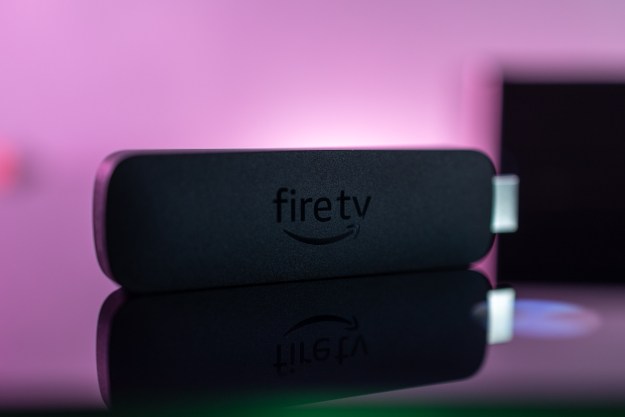
- Same great Fire TV experience
- Double the storage
- Improved processor
- Faster Wi-Fi
- Price is right
- Doesn't include the best Alexa remote
- Waiting on some new AI features
- Laggy interactions
This Amazon Fire TV Stick 4K Max review is one of those in which we’re just going to go ahead and cut to the chase. Just as the first-generation stick was the one to get if you were considering a Fire TV device, so, too, is the second-generation model.
It’s got the same excellent Fire TV experience, which Amazon continues to improve and refine. It’s had a little refresh to the internals, making it faster and adding storage, which is always a good thing. The price has gone up a smidge, but still falls well under the $100 threshold, and that’s before the inevitable sales that absolutely will happen.
And there are new experiences both visually and behind the scenes that leverage Amazon’s investments in AI that should make using a Fire TV Stick
In other words, if you’re going to buy a Fire TV Stick of some sort, you probably want the mouthful that is the Fire TV Stick
And now, after having spent a few days with a review unit sent by Amazon, we’ll show our work.
Video review
Fire TV Stick 4K Max hardware
There remain four options (what those of us in the biz call “SKUs”) in the Fire TV Stick lineup. The Lite lands at $30. The plain ol’ Stick is $40. The Fire TV Stick 4K is $50. And the new Fire TV Stick 4K Max is a penny shy of $60. The top end device is now $5 more than the previous generation when it launched in October 2021, but that’s the sort of delta (and overall price) that you really shouldn’t think twice about.
In all, you’re looking at a 100% difference in price between the low end and the high end, with a comparable difference in specs. The bottom two sticks top out at 1080p. The top two have their slight differences and are new for this late 2023 release cycle, but are separated by just $10.

You won’t notice any visual differences between the new Fire TV
Fire TV Stick
The bigger differences are on the inside. The Max has a faster processor (a Mediatek MT8696T at up to 2.0 GHz; the non-Max MT8696T CPU tops out at 1.7 GHz). The Max also has a faster GPU. Does any of that matter? Of course, it does. Is it something you’d actually notice while using the Fire TV? No.
One exception to that is with onboard storage. The Max has 16GB, and the non-Max has half that. Nobody ever wished they had less storage when things start to fill up. More is better. Not that you actually get all 16GB. We’re showing 12.86GB actually available, with about 11GB of that still free after first boot.
Another exception is the Wi-Fi. The Max supports Wi-Fi 6E. It’s not the latest standard (that Amazon is pushing in its newly released — and not inexpensive — Eero Max 7 router); it’s one back. Meanwhile the non-Max version is merely Wi-Fi 6.
Given the totality of all that — more storage, faster internals and better wireless — just go ahead and spend the extra $10. It’s a pretty easy decision.
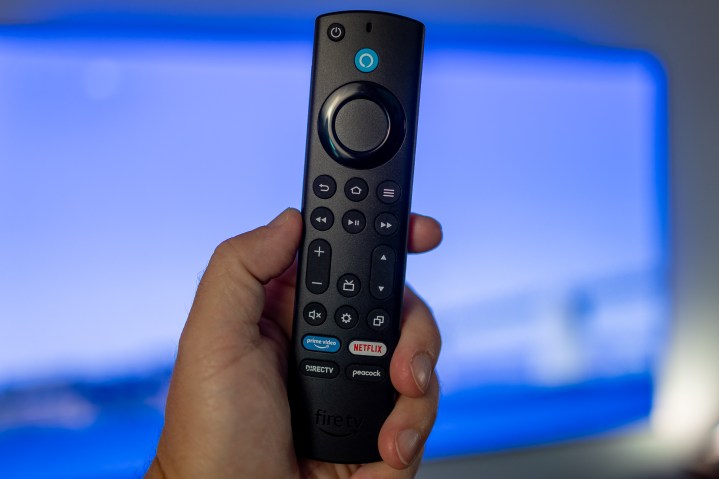
One other difference between the Max and non-Max: The remote control. This isn’t a huge deal, but it’s a noticeable one. The Fire TV Stick
Regardless, there’s still the big, blue
The remote in and of itself isn’t necessarily a deal breaker. And it also isn’t even the best
Fire TV Stick 4K Max software
Another year or two, another round of things getting steadily better. All Fire TV hardware continues to use
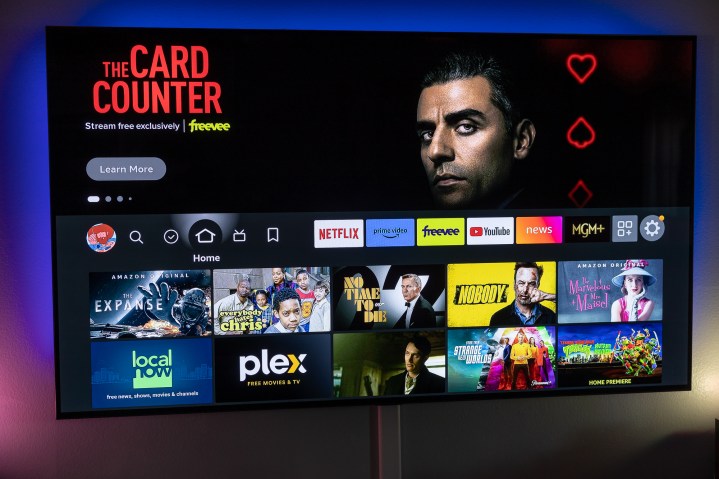
If you’ve used a Fire TV device of any sort the past few years, you already know what you’re getting in the new Fire TV Stick
The Fire TV experience is largely unchanged.
A lot of the Amazon Fire TV software experience is going to be what you make of it. How much you have in your watch lists. Or how much customizing you do to your apps on the home screen. Or, really, just how much you use your Fire TV device so that it starts surfacing content it thinks you want to watch (more on that in a second).
Fire TV’s user interface and Amazon’s entire user experience has gotten really good, and it continues to improve. If anything’s holding it back, it’s the hardware. There still are too many occasions where there’s too much lag. Optimizing software for hardware is its own level of alchemy, and it’s amazing that Fire TV is able to do what it does on the platform on which it’s working. But while the lag isn’t likely to bother normal folks as much as it does those of us who scrutinize these things for a living, it’s definitely apparent. And it definitely detracts from the overall experience — particularly when it comes to this next part.
The Ambient Experience
Of all the differences between the Fire TV Stick
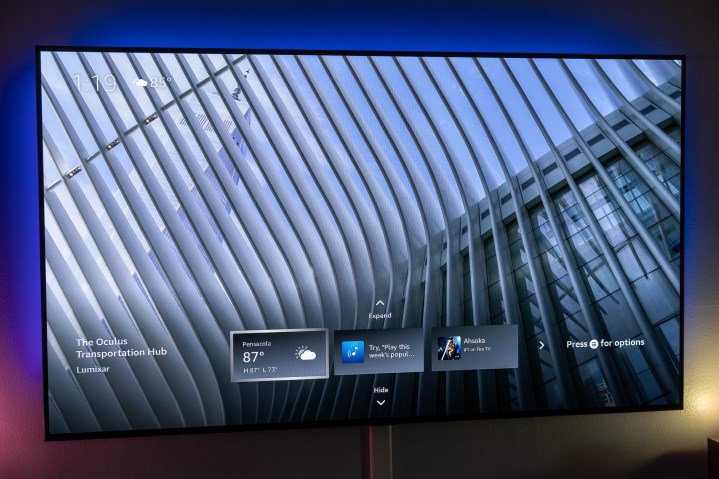
The Ambient Experience is really good. As the name implies, it’s a sort of glanceable background. It’s more akin to what
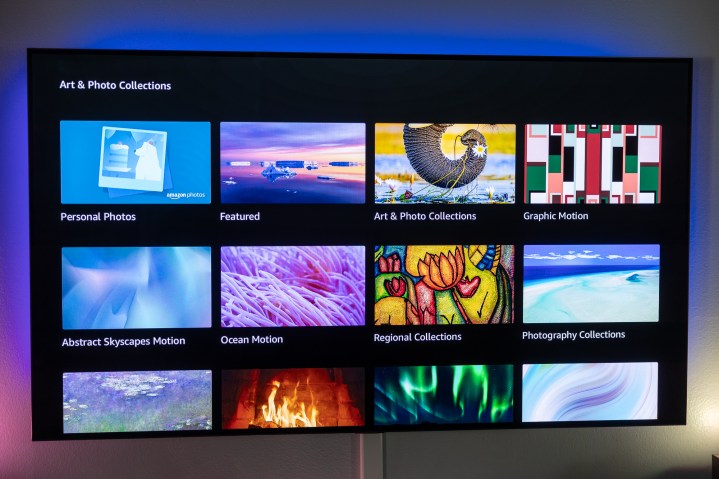
If you use Amazon Photos, you also can use your own photos as backgrounds, if you want.
What really makes the Ambient Experience different is its widgets, which have varying degrees of customization. So far, there are 10 widgets available from Amazon, including:
- Alexa Weather
- Calendar and Reminders
- Cookpad Recipe of the Day
- Live TV
- Music and Audio
- Smart Home Favorites
- Sticky Notes
- What Should I Watch
- What to Eat
- Your Deliveries
Again, the usefulness of each depends on your dependence on Amazon itself. Don’t use Amazon Music or Amazon Photos? That widget won’t be much help. That sort of thing. But they’re nicely designed.
The widgets also come in two sizes — small, which is the default — and large. I’d just leave them in the small size so that you can take in the beautiful backgrounds in the Ambient Experience. You can then expand the widget to its larger size using the remote.

It’s worth spending a few minutes in the settings of the Ambient Experience when you first get going — especially if you have an OLED television. The possibility of OLED burn-in is real, even if it’s not as much of a worry as it once was. But Amazon has smartly built in some options here for the widgets. You can set them to show all the time, or to show themselves when the Ambient Experience first launches, and then tuck themselves away until you want to see them again by pressing the up button on the remote. Or you can choose to never see the widgets at all.
But kudos to Amazon in any event for warning about OLED burn-in if you opt to have the widgets display all the time. Let’s hope the clock and temperature bugs don’t have the same concern. (We haven’t had them open long enough for that to be a concern, and you can always hide them if you want.)

The Ambient Experience is really well done considering how early we are into its life span. It’s also another instance in which the software lag rears its ugly head. Sometimes it’s when flipping between widgets. Other times it’s when you’re navigating within a widget, or opening up a full screen beyond that.
Lag is, and will continue to be, the enemy. And it’s souring an otherwise excellent experience.
AI still to come
Of course, you can’t get through a new product launch in 2023 without AI being included somehow. And that’s true for the new Fire TV fare as well.
Unfortunately, this isn’t something we can test just yet because it’s not going to be live until sometime later this year. But Amazon showed it off at its Devices and Services event at HQ2 in Arlington, Va., in late September. And since it directly affects the Fire TV
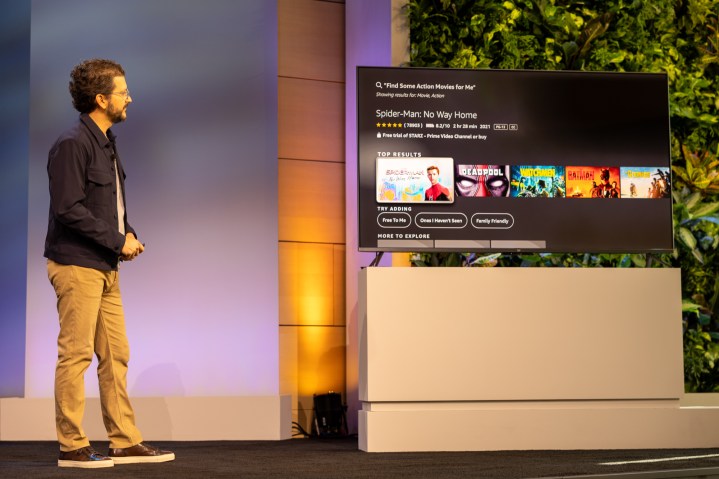
First of note is that search results on Fire TV are going to be supercharged. “We’ve completely reinvented the Fire TV search experience,” Daniel Rausch, vice president for
Never mind that only those of us of a certain age even know what a video store is, the point is taken. And the demo definitely showed better, more nuanced search results within Fire TV.
But we have to wait for them.
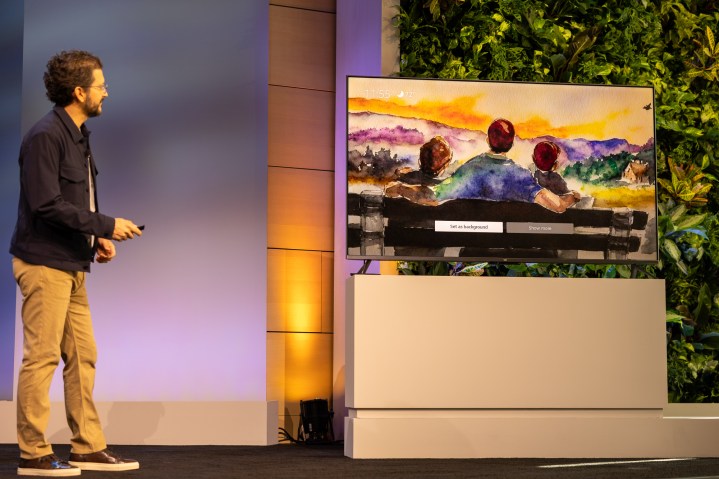
Rausch also showed a cool feature by which AI is used to create original backgrounds for Fire TV, or to make cool new versions of already existing photos. That latter part might well take your home pictures of family or whatever and turn them into something that’s more suitable for an ambient experience background.
Again, we have to wait for them on Fire TV later this year. But they’re coming.
The bottom line
We said this in 2021, led off with this again here, and it remains true a couple thousand words and two more years later: The Amazon Fire TV Stick
It has hardware that keeps the cost below the $100 mark, but still gets the job done, and ticks pretty much all the specs boxes you could want. It has software that gets better iteration after iteration. The new Ambient Experience is nice. The upcoming AI features should make the experience that much better.
There’s not much to complain about here. I’ll mention the lag again, because it’s probably the biggest opportunity for improvement, even if it’s the one that’s hitting a development ceiling the quickest. (And it’s also not a unique problem — Google hits the same wall with the low-cost Chromecast with Google TV.)
Ultimately, this purchase decision should come down to a couple things: Are you in the Amazon ecosystem? And do you need a new Fire TV Stick of some sort?
If the answer to those questions are “yes,” then you’ll do just fine with a Fire TV Stick
Editors' Recommendations
- Best Samsung TV deals: Save on 4K TVs, QLED TVs, OLED TVs, 8K TVs
- Sony debuts the Bravia 9, its brightest 4K TV ever, alongside new 2024 models
- Samsung’s new 98-inch DU9000 4K TV is just $4,000. Can it beat TCL and Hisense?
- Best TCL TV deals: 4K TVs as low as $150
- Best 65-inch TV deals: Get a 65-inch 4K TV for under $400





